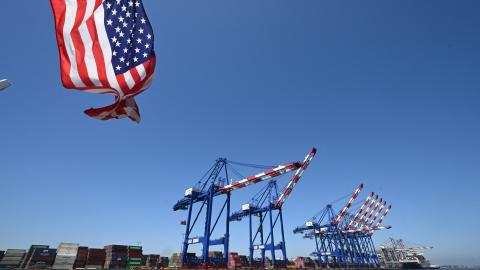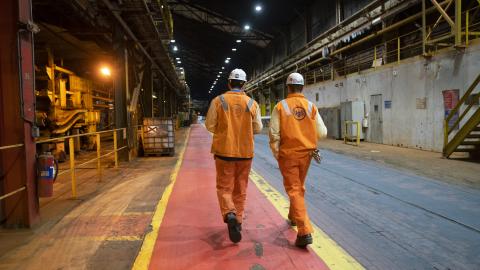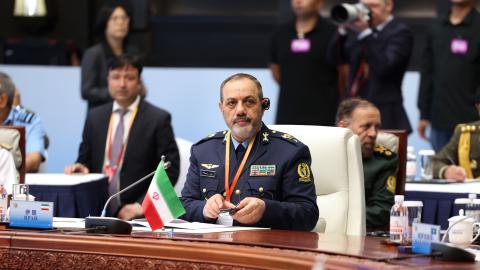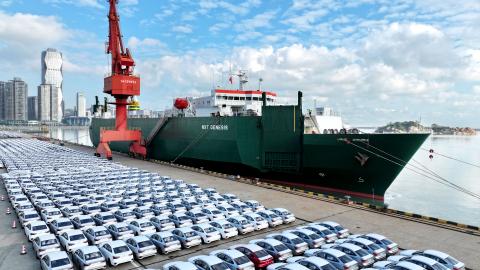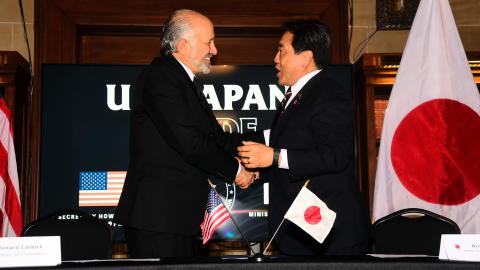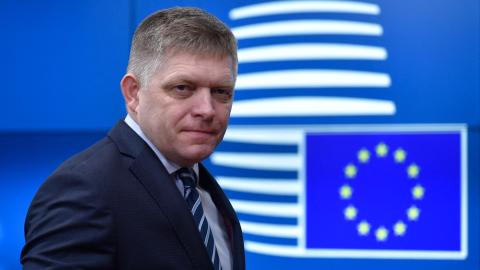Officials in NATO and European Union capitals were relieved with the outcome of the last parliamentary election in Slovakia in February 2020: Voters elected enough members of parliament to form a pro-Western coalition to govern the country of 5.5 million people. It came as a surprise because preelection opinion polls suggested a strong showing for the left-wing, nationalist, populist Slovak Social Democracy party, known as SMER-SD. Its victory would likely have led to pro-Russian, euroskeptic and statist economic policies.
But NATO and the EU may not like the outcome of the September 30 parliamentary elections, coming early after the government lost a no-confidence vote in parliament on December 15, 2022. Opinion polls show large numbers of Slovak voters will turn away from the parties that since 2020 have delivered growth, domestic reforms and the strongest geopolitical consensus since Slovakia joined NATO in 2004 and the EU in 2009.
Surveys show voters are almost certain to give a plurality to SMER-SD, led by former Prime Minister Robert Fico, who left office in 2018 in disgrace, and send at least one far-right party, Republika, and possibly another, the Slovak National Party (SNS), to the 150-seat National Council of the Slovak Republic, the nation’s parliament.
The election takes place against the background of two strong but contradictory trends: 1) the enormous progress Slovakia has made since late United States Secretary of State Madeleine Albright in 1997 referred to it as “the black hole of Europe,” even as the country faced major challenges in recent years from the pandemic and Russia’s war against Ukraine; and 2) a populace that is now among the most open in Europe to Russian narratives, with a strong opposition whose leader, Mr. Fico, seeks to modify, if not reverse, key domestic reforms and Slovakia’s Euroatlantic foreign policy. How did this happen?
A solid democracy emerges from ‘the black hole’
The Slovakia of 2023 is almost unrecognizable compared to the dismal tenure of Prime Minister Vladimir Meciar, who was in office for much of the 1990s. The country has also advanced since three-time Prime Minister Fico governed from 2006-2010 and again from 2012-2018. Bratislava scores well in rankings by the dozen most important U.S. and European institutions that assess countries based on democracy, rule of law and human rights.
The post-2020 governments led by Prime Ministers Igor Matovic, Eduard Heger and L’udovit Odor, with strong support from President Zuzana Caputova, elected in 2019, have taken rule of law and judicial reform issues seriously. They have made important strides, even if they have not delivered as much as voters want.
Between 1993 and 2019, authorities convicted only two ministerial-level officials for corruption. Since 2019, the government set up important new judicial and law enforcement structures. This has led to charges or convictions against more than 60 officials implicated in corruption, including Mr. Fico and a former special prosecutor. A case against the SMER-affiliated head of the Central Bank is ongoing. Transparency International has taken notice, giving Slovakia its highest-ever ranking.
However, there have been prominent setbacks, such as the acquittal in May 2023 of Marian Kocner, widely believed to have ordered the murder of the journalist Jan Kuciak and his fiancee Martina Kusnirova in March 2018. The assassinations led to mass countrywide protests and the fall of the Fico government.
Yet, overall, the post-2020 governments have acted as a strong democratic bulwark in Central Europe.
A strong pro-Western orientation solidifies
Slovak governments since 2020 have also pursued the most Euroatlantic foreign policies since 2006 and arguably even since independence in 1993. In 2021, parliament approved a national security strategy that for the first time called the U.S. a special partner and ally and referred to Russia and China as “threats.” In early February 2022, parliament ratified a defense cooperation agreement with the U.S.
After Russia launched its full-scale war against Ukraine in February 2022, Slovakia has been a particularly staunch supporter of Ukrainian sovereignty and independence. All governments have backed strong EU sanctions against the Kremlin and have actively provided military assistance, for example becoming the first NATO member to provide an S-300 air defense system and MiG fighters.
Earlier this year, Slovakia ranked fifth in the world on assistance to Ukraine as a percentage of gross domestic product (GDP). It has major defense industrial capacity, especially in large caliber ammunition, which it has been producing in large quantities for the Ukrainian military. In March 2022, parliament approved the hosting of a NATO battle group with some 2,000 multinational troops.
The same month, the government expelled three Russians and capped Russian Embassy staff at 35, leading to the expulsion of a further 34. This reaction contrasts with the SMER government’s reaction to the poisoning of Sergei Skripal and his daughter in Salisbury, England, in 2018, when Slovakia was the only EU member state other than Austria not to expel any Russian intelligence personnel.
In April 2022, then-Prime Minister Heger was in the first group of EU member state leaders to visit the site of Russian war crimes in Bucha. Slovakia has since then been among the strongest advocates of Ukraine’s accession to the EU and NATO. Michal Simecka, the Oxford-educated Slovak vice president of the European Parliament, has led the campaign to recognize Ukraine’s EU candidacy. The government bolstered its military, purchasing Black Hawk helicopters in 2021 and BAE Infantry Fighting Vehicles in 2022, which put the country above its Wales Pledge of 2 percent GDP spending on the military for that year. Slovakia has also been generous to Ukrainian refugees.
The economy performs well with some trouble spots
Nicknamed the “Tatra Tiger” in the early 2000s for its strong economic performance, Slovakia has also performed relatively well in recent years, and the country is more prosperous than ever, even if inflation and unemployment are high and east-west income disparities are significant. Infrastructure and social service delivery also remain underdeveloped. Slovakia’s budget deficit is the highest in the EU and a cause of concern for the long-term sustainability of public finances if the next government does not undertake reforms.
Slovakia produces the largest number of cars per capita in the world, with an industry that plays a huge role in the economy and links it closely with Germany, its main trading partner, export market and among its top employers. Nevertheless, the Bratislava-based GLOBSEC think tank has warned that if the industry does not transition to electric vehicles faster Slovakia’s GDP could decline by as much as 10 percent and employment by 4.5 percent. Slovak policymakers are very aware of their dependence on the German car industry, its slowness in transitioning away from the internal combustion engine and are pushing to retool quickly for the electric vehicle era.
Slovakia remains highly dependent on Russian gas (60 percent) and oil (95 percent) but is making steady progress on diversification. The government is also striving to diversify away from its 100 percent dependence on Rosatom for nuclear fuel and has been actively negotiating with foreign partners to reorient its two reactors at Bohunice and three at Mochovce, which generate some 75 percent of the country’s electricity, away from Russia. In August, the government concluded a nuclear fuel supply agreement with Westinghouse, which will reduce dependence on Russia further. Bratislava is also looking closely at small and medium reactor (SMR) technology, recently joining the U.S.-sponsored SMR Phoenix Project together with the Czech Republic and Romania.
Why Slovakia may reverse course
Despite these positive trends, the battle over Slovakia’s strategic direction is a continuation of a struggle that goes back to the 1990s, when then-Prime Minister Meciar began using the term “bridge” to describe the country’s place between the EU/NATO and Russia, taking pro-Russian positions and advancing pro-Russian narratives. Almost half of the population buys into the “bridge” concept. Public support for NATO is tied with Bulgaria as the lowest among Eastern Flank member states.
For years, GLOBSEC opinion surveys have shown that some 35 percent of the population sees the U.S. as a “threat,” while in 2023 the number rose to 50 percent. Only about 50 percent of the population supports the presence of U.S. forces on Slovak soil. While Russia’s war against Ukraine increased the percentage of Slovaks who see Washington as a partner and ally – rising from 20 percent in 2021 to 62 percent in 2022 – those numbers have softened. Slovakia leads Central Europe by far (66 percent vs. 56 percent for Bulgaria) in “agreeing with the statement that the U.S. is dragging my country into war with Russia because it is profiting from it.” Polls show 58 percent of Slovaks would vote to remain in NATO if a referendum were held now, on par with Bulgaria. Yet confidence in NATO and the U.S. as a security guarantor is also lowest in the Central Europe region, along with Bulgaria.
The Slovak populace is the most pro-Russian in Central Europe and among the most pro-Russian in the EU. Anti-Western narratives are widespread. The Kremlin sees Slovakia as a weak link in NATO and the EU and has focused its influence operations and disinformation campaigns heavily there, further polarizing society and weakening support for government priorities.
Slovakia has the largest number of pro-Russian media outlets and Facebook pages in the EU. Indeed, the government says the Russian Embassy produces more disinformation on its Facebook site than Russian embassies in London, Paris and Berlin put together. Slavophilism and pan-Slavism in the population, combined with a proclivity to conspiracy thinking and exhaustion from the pandemic and other economic stresses, make Slovakia fertile ground for Russian disinformation efforts. Slovaks have the least positive perceptions of Ukrainian President Volodymyr Zelenskiy in Central Europe, even less than Hungary (31 percent vs. 41 percent).
Substantial percentages of the population say they believe President Caputova and the governing coalition take their orders from the U.S. Embassy, an absurd proposition that recycles an old KGB narrative. The Slovak government has responded, for example, by closing the major disinformation portal Hlavne Spravy, which officials say was financed by the Russian Embassy. A Slovak court this year convicted a Slovak freelance writer for that portal of espionage after he was filmed taking money from a Russian intelligence officer. To combat these trends, Bratislava has established dedicated strategic communication units in several ministries and increased cooperation with the EU and U.S., while Meta/Facebook closed the account of Slovakia’s most notorious influencer, SMER MP Lobos Blaha.
Ms. Caputova attributes the success of Russian narratives in part to Slovakia’s young democracy. GLOBSEC attributes these phenomena in part to historically weak popular trust in public institutions.
How has it come to this?
Popular anger against the SMER-led government in 2018-2019 propelled a four-party center-right coalition led by OL’aNO (Ordinary People and Independent Personalities) into office after the February 2020 elections. Taking office at the beginning of the pandemic, then-Prime Minister Matovic had an inauspicious start with its high economic and social costs.
In addition, after winning over voters with promises to deliver the “best government in Slovak history,” Mr. Matovic governed erratically. His surprise purchase of untested Russian Sputnik vaccines early in the pandemic dogged him politically and contributed to his decision to resign in 2021 after about a year.
Mr. Matovic’s successor, Prime Minister Heger, performed well, continuing the domestic and foreign policy course for more than two years. But tensions between party leaders plagued his government and he resigned on April 15, 2023, after the coalition almost came apart numerous times. He was replaced in May by the technocratic government of Mr. Odor, the first caretaker government in Slovak history. Despite its achievements, polls say some 80 percent of the population thinks the country is going in the wrong direction. SMER, the far-right opposition parties and Russia have exploited this discontent.
During this turbulence, President Caputova has played a positive, stabilizing role, using her strong moral standing to guide the country forward. She has warned publicly that Slovakia is “facing an epidemic of populism, lies which become the truth for some people after being repeated hundreds of times.” A political novice and environmental lawyer when she was elected in March 2019, Ms. Caputova remains the most trusted figure in Slovakia despite waning popularity. She generates sympathy after smear campaigns and death threats by extremists against her and her family. Her recent decision not to seek a second term leaves that race, which will be decided in 2024, wide open. Former Foreign Minister Ivan Korcok’s recent candidacy is a positive development.
The SMER challenge
The popular discontent sets the stage for a comeback for the disgraced Mr. Fico, who has intensified attacks on the government’s domestic and foreign policies in his quest for power. Parliament has refused to lift his immunity, thus keeping him out of jail. Abuse of power charges against him were dropped on the grounds of alleged procedural errors by the police and he is determined to rehabilitate his reputation.
Some observers speculate that Mr. Fico will take a pragmatic approach to key issues if he forms a government because of the realities of governing, arguing that he has done so in the past. The Fico of 2023, however, is not the same politician he was in the past. The EU and international landscape is more fragmented and the stakes are higher. While SMER party officials say he would continue to support Slovakia’s NATO membership and EU membership for Ukraine, he has become even more radicalized, running a campaign that openly spreads pro-Kremlin propaganda, blames Ukrainian “fascists” for launching the war in 2014 and calls the Ukrainian president a “threat to Slovak interests.” If he wins, he will stop supplying weapons to Ukraine and oppose NATO membership for Ukraine and complicate consensus-making in the EU and NATO on key issues.
Mr. Fico also likens the NATO battle group in Slovakia to the Wehrmacht and calls President Caputova an “American agent.”
Voters recently received fresh reminders of corruption and criminality in SMER. Authorities in August arrested former chief of police and SMER candidate Tibor Gaspar for links to organized crime and charged Slovak Information Service Chief Michal Alac, his predecessor Vladimir Pcolinsky and National Security Authority Director Roman Konecny with supporting a criminal group, abuse of authority and obstruction of justice.
Scenarios
The results of the election could be momentous. The forces of reaction are on the upswing after several relatively good years for reformist, Euroatlanticist Slovakia. The Slovak electorate is more polarized between pro-Western and pro-Russian camps, both of which are divided into several parties, which could well translate into a fragmented parliament. The small parties will likely decide the next government’s foreign policy direction. Slovak voters are frustrated and apathetic. Economic issues will likely influence their vote but the broader SMER agenda will as well. However, opinion polls prior to recent elections have been deceiving. Surveys taken shortly before the 2019 and 2020 elections, for example, showed robust support for SMER and far-right parties but voters chose pro-Western options. Many voters remain undecided and preferences have shifted in the final weeks of past campaigns. Several scenarios are possible.
A Fico-led coalition
All opinion surveys show SMER is likely to win a plurality. It is polling well above the others in the low 20s, which would give Mr. Fico the first crack at forming a government. His natural coalition partners are on the far right – Republika and SNS – and potentially HLAS, whose voter base overlaps heavily with that of SMER and is led by his successor, former Prime Minister Peter Pellegrini. SMER could form a government if Republika and SNS do very well, but Mr. Fico may need more MPs to reach the minimum 76 seats in parliament. Fico has been fighting so hard for power and rehabilitation that it is difficult to imagine he would not want a fourth term as prime minister. Any scenario with SMER in power would pursue policies more friendly to the Kremlin and be less reformist. Many commentators predict he will approach key policy issues similarly to Hungarian Prime Minister Viktor Orban.
A centrist coalition with center-left and center-right parties
If Mr. Fico is unable to cobble together a coalition and Progressive Slovakia (PS) comes in second, as polling suggests is likely (mid-teens), it will receive the mandate to try to form a government. PS has been rising steadily in popularity and is likely to return to parliament with a bang, but to form a government would require center-right parties to do very well and possibly some HLAS MPs to join. This outcome would send a strong signal of continuity on major domestic and foreign policy priorities but could presage governmental instability, as has been the case with post-2020 coalitions.
A left-leaning coalition
If PS also fails to form a government, the task would likely fall to Mr. Pellegrini, whose HLAS party is polling third even as it has been falling in popularity and is in the low teens. He would presumably look for MPs from SMER, PS and the smaller parties to join under his leadership. He governed somewhat responsibly as prime minister in 2018-2020 and as the acceptable face of the then-SMER government. For example, he signed off on the largest military purchase in Slovak history – F-16s in December 2018. He has tried to calm concerns about Slovakia’s foreign and domestic policy, observing in July that he “can’t imagine being in the same cabinet with Fico.” He has staked out middle positions on Ukraine, condemning Kremlin aggression but prioritizing Slovak interests. Most insiders do not consider this scenario likely.
